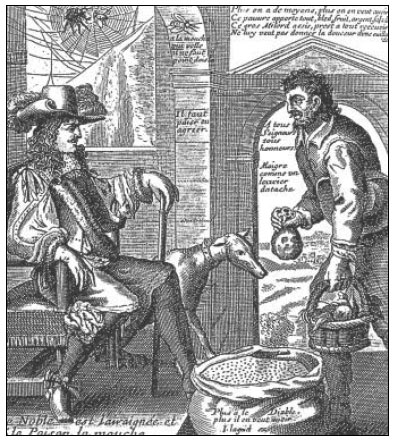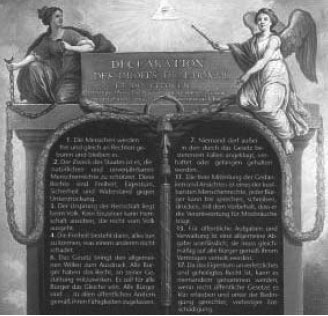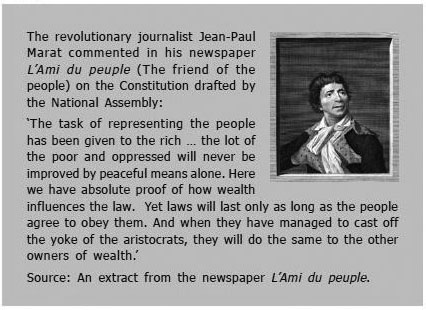Question 1:
Describe the circumstances leading to the outbreak of revolutionary protest in France.
Or
Describe the political, social and economic circumstances leading to out break of revolutionary protest in France?
Answer:
The circumstances leading to the outbreak of revolutionary protest in France were as follows:
- The French Revolution was an uprising of the French people against the prevailing monarchy and aristocracy. The French society was a feudal one that was ridden with inequalities.
- The clergy and the nobles belonged to the privileged class. They led a life of luxury and exploited the common people.
- The peasants and workers, which made up most of the population, were compelled to live a miserable life. They were forced to pay heavy taxes and perform hard labour.
- The middle class comprising of lawyers, doctors, teachers, traders and petty government officers were wealthy and wise, but were deprived of any political rights. They suffered humiliation at the hands of clergy and nobles.
- The social inequalities and luxurious lives led by the clergy and nobles created discontentment and restlessness among the common people.
Political causes or political conditions:
- The kings of France were despotic rulers. They believed in the Theory of Divine Rights of Kingship. They claimed themselves to be the representatives of God on earth.
- On the eve of the revolution, Louis XVI was the king of France. He was an autocratic
ruler.
He and his queen, Marie Antoinette squandered the state revenue on luxuries and wasteful festivities. The high government posts were auctioned. As such corruption, maladministration and inefficiency reigned supreme. - On the eve of the revolution, Louis XVI was the king of France. He was an autocratic
ruler.
He and his queen, Marie Antoinette squandered the state revenue on luxuries and wasteful festivities. The high government posts were auctioned. As such corruption, maladministration and inefficiency reigned supreme. - There were different laws in different areas and due to the absence of any uniform system, the condition worsened, thus creating confusion. People were dissatisfied with the government.
Economic causes or economic conditions:
- The shattered economy of France proved to be a major cause of the revolution. Due to prolonged wars and extravagant habits of the royal family, the French government reached the state of bankruptcy.
- The clergy and the nobility owned almost 96% of the wealth of the country.
- The common people were too poor to pay taxes and the corrupt system of taxation added to their miseries.
Psychological causes:
- In the second part of the 18th century, there was an intellectual Renaissance in France.
The Great
French philosophers like Montesquieu, Rousseau and Voltaire exploited the social
shortcomings.
They fanned the flame of revolution. - The American Revolution and the Declaration of Independence by the American revolutionaries inspired the people of France to overthrow the oppressive king.
Immediate cause:
In 1788, there spread a severe famine in many parts of France. People suffering from hunger
assembled
in the streets of Paris. The state treasury had fallen empty. Emperor Louis XVI was
compelled to
summon a meeting of the Estates General in 1789 after a lapse of 175 years. The first two
Estates i.e.,
the clergy and nobility refused to have a common meeting with the Third Estate. It generated
much
excitement and people lost their temper. With the meeting of Estates General on 5th May,
1789 the
French Revolution began.
Question 2:
Which groups of French society benefitted from the revolution? Which groups were forced to relinquish power? Which sections of society would have been disappointed with the outcome of the revolution?
Answer:
(i) The Third Estate benefitted a lot from the revolution. This comprised the professional
classes,
small and big businessmen, peasants, landless labourers and servants. Most of them got land
to
till, the burden of taxation was removed and the rule of law was established.
(ii) The First and Second Estates were forced to relinquish power, the churches were shut
down
and the church property was confiscated. The predominance of the First and Second Estates
over administration, social and economic privileges were abolished and equality was
established.
(iii) The common people were disappointed with the outcome of the revolution. Although
principles
of equality, liberty and fraternity were implemented in France, the French society remained
a
divided house between the ‘haves’ and ‘have-nots’. The social and economic conditions of the
common people did not improve as much as they had expected.
Question 3:
Describe the legacy of the French Revolution for the peoples of the world during the nineteenth and twentieth centuries.
Answer:
The legacy of the French Revolution for the people of world during the 19th and 20th centuries can be explained under following heads:
- Equality: Equality was one of the major principles of the French Revolution. The distinction between the poor and the rich was removed. Every government began to give equal rights to the rich and the poor.
- Liberty: Before the French Revolution, freedom meant political freedom but now freedom
meant
social and religious freedom too. The welfare of the people was to be the duty of the
rulers.
Therefore, they were no longer absolute kings. - Fraternity: The idea of fraternity also got an impetus from the French Revolution.
- Democracy: Monarchical systems gave place to the democratic systems.
- Welfare of the people: Governments all over the world began to think about the welfare of the people as its duty. The children were stopped from working in the factories. The conditions in the factories were improved. A number of steps were taken to improve the working conditions in the mines.
Question 4:
Draw up a list of democratic rights we enjoy today whose origins could be traced to the French Revolution.
Answer:
Some of the rights that we enjoy today originated from the French Revolution. Equality, liberty and fraternity were the basic principles of the Declaration of the Rights of Man and Citizen declared by the French National Assembly on 27th August, 1789. The following are the democratic rights that we enjoy today which came into existence due to French Revolution:
Question 5:
Would you agree with the view that the message of universal rights was beset with contradictions? Explain.
Answer:
The message of universal rights was definitely beset with contradictions. It had the following defects:
- Nothing was given in it about organising a meeting and the freedom to make associations.
- Nothing was mentioned about the subject of public education.
- It did not give the freedom of trade and occupation.
- It gave limited rights to citizens for owning property. State was free to confiscate anyone’s property with the excuse of public welfare.
- Improvement in the condition of black slaves working in the French colonies was also not mentioned.
- It did not determine any duties without which, the rights were considered baseless.
Question 6:
How would you explain the rise of Napoleon?
Answer:
Rise of Napoleon: In 1799, Napoleon became the First Council after overthrowing the rule of Directory. He acquired numerous powers and even opted for a plebiscite in which 99.9% people voted for his new administrative system. He not only conquered new areas but also made peace treaties with the enemies. All this proves that he was an able administrator. He implemented many reforms from 1799 till 1804 which are given as follows:
- He stopped inflation through financial reforms.
- He established the Bank of France.
- He resolved the long-time confrontation with the Pope which was started with the confiscation of church’s property in 1789. For this, he even declared Catholic religion as the religion of the majority of French people.
- Later on, he introduced the Napoleonic code which became the basis of French legal system in the future.
Napoleon as a king: Till 1804, Napoleon was not satisfied with his role as the First Council. He again opted for a plebiscite and achieved what he wanted. In December 1804, he was crowned as the king of France. In this way, Napoleon rose to power.
Question 7:
Explain why the artist has portrayed the nobleman as the spider and the peasant as the fly.

Answer:
In the given picture, the artist has portrayed the nobleman as the spider and the peasant as the fly, to depict the social reality of the France at the time of the French Revolution. The nobleman lived due to the labour of peasants just as a spider. The peasant had to pay several feudal dues and had to perform all kinds of services whereas the nobleman led a life full of luxury and extracted his income from the peasants.
Question 8:
Fill in the blank boxes with appropriate terms from among the following:

Answer:
1. Scarcity of grain 2. Rising food prices 3. Food riots 4. Weaker bodies 5. Increased number of deaths
Question 9:
Representatives of the Third Estate take the oath raising their arms in the direction of Bailly, the President of the Assembly, standing on a table in the centre. Do you think that during the actual event Bailly would have stood with his back to the assembled deputies? What could have been David's intention in placing Bailly (see the picture) the way he has done?

Answer:
We do not think that during the actual event Bailly would have stood with his back to the
assembled deputies.
The artist, through this image, tried to portray the events related to the French Revolution
of 1789.
Through this painting, David tried to make sure that the constitution did nothing in favour
of the
general masses. The Constitution of 1791 vested the power to make laws in the National
Assembly,
which was indirectly elected. Citizens voted for a group of electors, who in turn chose the
Assembly.
The right to vote was not equally provided to citizens. The Constitution began with the
Declaration of
the Rights of Man and Citizen which granted rights such as the right to life, freedom of
speech, freedom
of opinion and equality before law. These were natural and inalienable rights, i.e. they
belonged to
each human being by birth and could not be taken away.
Question 10:
Explain the meaning of the painting of the Declaration of Rights of Man and Citizen by reading only the symbols.

Answer:
The meaning of different symbols in the painting of the Declaration of Rights of Man and
Citizen is described as follows:
(i) Blue, white and red colors: These are the national colours of France.
(ii) The winged woman: It represents the personification of the law.
(iii) The Law Tablet: It represents that the law is the same for all, and all are equal
before it.
Question 11:
Compare the political rights which the Constitution of 1791 gave to the citizens with Articles 1 and 6 of the Declaration of the Rights of Man and Citizen. Are the two documents consistent? Do the two documents convey the same idea?
Answer:
Yes, the political rights given in Articles 1 and 6 of the Declaration convey the same idea
that all
human beings are born free and remain equal in the eyes of the law.
Though they convey the same idea, the declaration failed to give a practical shape to these
ideas
as only a few were given the right to vote ‘on certain conditions’. Those who were given the
right
to vote were called active citizens, while the remaining were categorised as passive
citizens.
Question 12:
Which groups of French society would have gained from the Constitution of 1791? Which groups would have had reason to be dissatisfied? What developments does Marat (Refer to Source given) anticipate in the future?
Answer:
The groups of French society which would have gained from the Constitution of 1791 were the
aristocrats or the rich classes.
The groups which would remain dissatisfied were the peasants, workers and women.
Marat anticipated that the future would show the dissatisfaction of the poor sections
through retaliatory
actions.

